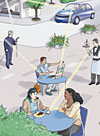Strategic planning for the future at Siemens
With its “Pictures of the Future” approach, Siemens takes a long look into the future: 10, 20 or even 30 years, depending upon the area of activity. The goal is “to identify promising technologies and future consumer wishes and to discover new business possibilities”. The result of Siemens’ methodical approach to strategic planning is “a coherent vision of tomorrow’s world”.
Here are some of the the important future trends that Siemens identified:
- Information and communications
Globalization, individualisation, mobility and self-organisation are the driving forces in the field of information and communications technology. Today’s business processes require real-time availability of information coupled with an end-to-end security philosophy across all processes. In the future, all objects of daily life will be able to communicate, thus enhancing user comfort and fulfilling other needs regarding design and emotional content. In turn, entertainment and communication will converge, with applications being accessible from anywhere at any time via, for example, mobile devices featuring intuitive user interfaces.- Feature article:
view as html – download (pdf, 729 kb, 4 pages)
- Feature article:
- Transportation
Mobility is not just a need of the industrialised nations – passenger traffic and goods transportation in industrialised developing countries is also growing rapidly. The automobile of the future will “tank” fuel and software. It will independently warn the driver of hazards and traffic jams – sensors and communications networks make this possible. Paying with smart cards and constantly updated traffic information will increase commuting comfort.- Feature article:
view as html – download (pdf, 759 kb, 4 pages)
- Feature article:
- Health
Information and communications technologies are among the strongest forces driving the health-care market. Tomorrow’s innovative IT and communications solutions will be more powerful than their predecessors, and they will be an important tool for physicians and medical personnel – as well as for health insurance providers and pharmaceutical companies. Home-based care (i.e., medical care of patients in their own homes) will become more widespread. With new procedures and processes for diagnosis and therapy, the vision of medical care customised to a patient’s individual needs will become a reality.- Feature article:
view as html – download (pdf, 733 kb, 4 pages)
- Feature article:
- Services
The importance of the service sector is growing, in particular, personalised services that are user-oriented. For example, it will be possible to get individualised rates and using technical instruments will be easier. Virtual assistants collect information on the internet. Intelligent cameras and biometric systems ensure a high level of security. Remote maintenance and automated services will become an everyday element of professional and private life in the future.- Feature article:
view as html – download (pdf, 805 kb, 4 pages)
- Feature article:





[…] [thanks, business innovation insider and putting people first] […]